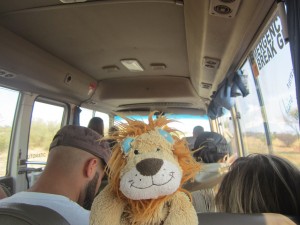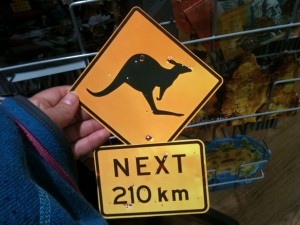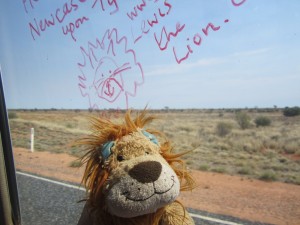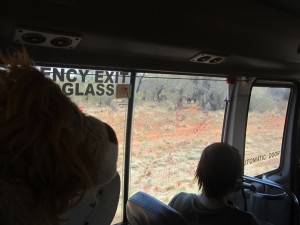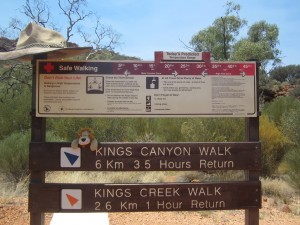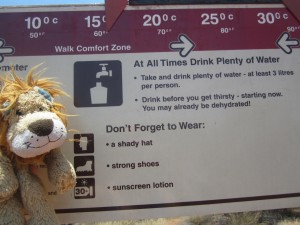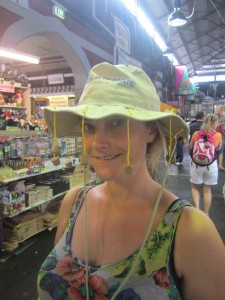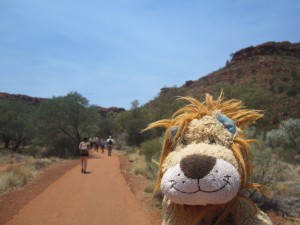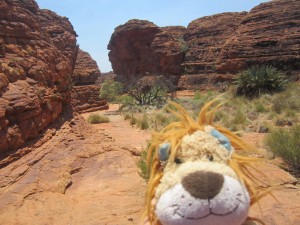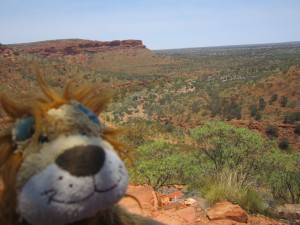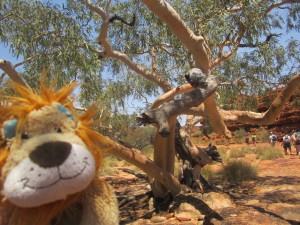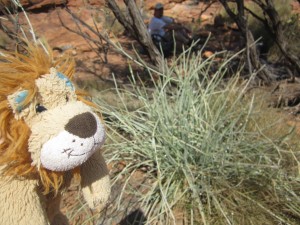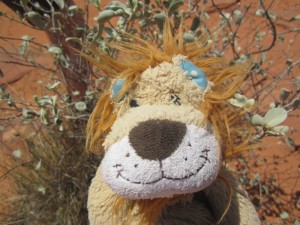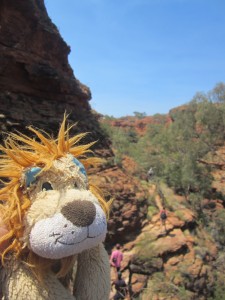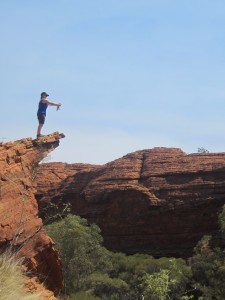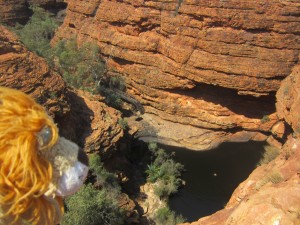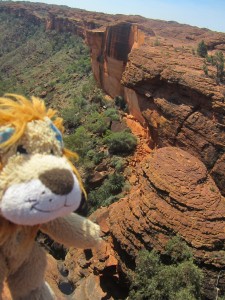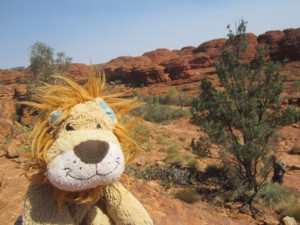When Lewis the Lion arrived in the centre of Alice Springs, he was surprised that for being such a tourist hub for travellers from around the world, that the place looked a bit run down, as if the sun had beaten everything down, the buildings and the Aborigines included. He could see many indigenous people dressed in Western clothes hanging around under trees like vagabonds without purpose. It all felt quite depressing really. He had just missed a Sunday market where local people had been selling crafts but he was off to confirm his special three day tour the next day with the Rock Tour Company.
The bus duly picked him up at 6 o’clock sharp the next morning outside his hostel. Like the flight to Alice Springs, there was no short journey out here in the Australian outback, just miles and miles of a seemingly never ending road. This road cut through the red earth, strewn with yellowing scrubland and numerous burnt, black gnarled trees, together with green, feathered trees and bushes.
After leaving the town behind, the bus kept on going for 6 hours with nothing to break up the landscape. The only thing that made Lewis the Lion smile were all the signs to warn drivers of bounding kangaroos!
As the signs at the airport suggested, this place was a magnet for tourists from all over the world. The driver and tour guide who had the nickname, Camel, asked the passengers to draw on the windows of the bus their names and where they came from.
Lewis clocked up ten different nationalities of these 21 people alone: Dutch, English, German, Swedish, Taiwanese, Korean, Tasmanian, Danish, Norwegian and America. This seemed to be a repeating story for Lewis the Lion on this amazing adventure: what a fabulous thing to share these experiences with people from all over the world!
The only thing to break up the monotony of the landscape was when the bus slowed to allow wild horses to cross the roads.
In fact, Lewis the Lion was surprised to discover that Australia was home to many wild horses. But more surprising still was that besides wild kangaroos, possums, wombats and dingoes, that Australia had over a million wild camels! Who would have thought that? He had always associated camels with the Middle East. However, like the Middle East he was after all in a desert terrain but he will tell you more about Australian camels in one of his next blogs. Camel refused to put the air-conditioning on on the bus as he said that the passengers had to acclimatise to the heat for their three-hour hike later that day. Helpfully, he had written the forecasted temperatures right on the front windscreen:
Monday – 35 degrees
Tuesday – 36 degrees
Wednesday – 37 degrees
This was accompanied by some very important advice: Drink lots of water! He in fact told this group of tourists that no-one was going on this afternoon’s walk without at least three litres of water each: one litre of water per hour. He also told the group to make sure that they were drinking plenty of water before they got there as he didn’t want anyone suffering from dehydration. ‘Very sensible advice!’ Lewis the Lion thought to himself as he remembered the time when Helen had come close to collapsing whilst walking in the Colca Canyon in Peru. This time she would not only be drinking water but wearing a cap too, that’s for sure. Lewis the Lion also remembered some of the good advice he’d received from his friends in school back in England. This was a time to lather on the suntan lotion too (or sunscreen as they called it in Australia) and thankfully, Helen had a bottle of Factor 50 with her to protect her sensitive, white British skin.
This sound advice on drinking water was again reiterated when Lewis the Lion reached the start of his 6 km walk in the Kings Canyon.
First of all there was a sign stating the daily weather conditions,
followed by a sign stressing the importance of drinking enough water. It said that there were extensive sections of the 6 km walk where there was no protection from the sun and it also advised the use of a hat and sensible footwear.
As Lewis the Lion commenced the Kings Canyon Rim Walk through the red terrain, the first thing he noticed were the incessant flies, like bluebottles, hitting off his face. His tail started to wag as he tried to flick them away. Annoying as they were, at least they didn’t seem to bite and he could understand why he saw several walkers wearing mosquito nets over their faces or the traditional style Aussie hat with the pieces of string with dangling corks!
As Lewis the Lion started his walk, the thing that struck him the most was the colour of the landscape around him: a mass of deep oranges and russets.
It rather reminded him of his recent trip to the Grand Canyon in America as here too, the rocks seemed to be formed from layers of sedimentary rock: like lots of plates stacked up on top of each other.
The first part of the walk was definitely the most challenging part of the day as under the beating sun, there was a steep climb to the top of the Canyon. With true Aussie sense of humour, they had renamed the climb as ‘Heart-attack Hill!’ Lewis the Lion took it slowly and steadily and even though it made him slightly breathless and sweaty, in no time at all he was surprised how high up they were, looking down at the car park below.
Camel, Lewis the Lion’s tour guide, told the group that the Kings Canyon whose walls stood 100 metres high was the biggest canyon in the world. Lewis was a bit perplexed by this. From his recent visit to the Grand Canyon, he was sure that its deep ravine between the cliffs seemed bigger? But Camel went on to explain that the Grand Canyon had been wrongly named as it was in fact a gorge. The difference being that a gorge is carved out by a river (in the case of the Grand Canyon the Colorado River).
Camel then went on to talk about the different plants and trees that surprisingly seemed to flourish in this desert-like environment. In the way that Lewis the Lion had learnt about how the indigenous people in the Amazon Rainforest had used plants to their advantage, he discovered that the same was true for the Aboriginal people of the Watarrka National Park.
First of all he learnt that the powdery, silver-coloured Ghost Gum Tree acted as a natural suntan lotion for the indigenous people. It also rather cleverly grows lots of trunks so that it can survive in the harsh desert environment.
He also noticed lots of clumps of spinifex grass: incredibly a grass which grows out of the sand dunes.
But the grass in the middle of the desert wasn’t Lewis the Lion’s only surprise. There was even mistletoe here! Lewis the Lion had always associated mistletoe with Christmas and the cold but here it was in the middle of an arid desert landscape: quite incredible.
Camel went on to tell him that nothing dies in the desert, even during extended periods of drought: it just lies dormant, waiting for the next rains to come. Even kangaroos can pause a pregnancy during times when water is scarce. Lewis the Lion marvelled at nature’s ability to adapt and survive in even the harshest of environments.
The walk from the top of the impressive Canyon then took the walkers over broken, rocky ground near steep cliffs and deep crevices. Luckily it had plateaued out somewhat but Camel explained to the group that the harshness of the environment often reflected the severity of punishment within the local indigenous communities. For example, he explained that if someone had committed a crime then the poisonous mulga bush was rubbed into eyes which would blind them for a few days. Or again this poisonous bush would cover the tips of spearheads which would then be driven into the muscles at the top of the thighs for more serious crimes and offences. Worst of all, was a sure death sentence, for example if someone had deliberately poisoned a watering hole, the perpetrator would be left abandoned in the outback. For sure whilst Lewis the Lion wandered around on this sacred Aboriginal territory, he would make sure that he was as good as gold!
Going down some steep, wooden staircases to the Garden of Eden, Lewis the Lion could see a lookout point that he just had to get to. It reminded him so much of the Disney cartoon, The Lion King and just for a few moments he wanted to pretend that he too was like Simba: King of the Jungle, looking down on his kingdom outstretched before him. Helen held him up high over the canyon floor and stretched out his little paws for him. Lewis did think it was fun!
Not much further along the rim of the Canyon, Lewis the Lion could see an inviting watering hole below.
Normally, he would have loved to have dived in, especially under the sweltering heat but he had been warned of high toxin levels in the water and so thought that it was best avoided. Best that he stick to drinking his water for now.
From the top of the rim, Lewis the Lion marvelled at how millions of years had formed this incredible landscape: the rocks, the wind and water. It looked as if a big slice of rock had fallen to the ground below on one of the canyon walls as you can see in this photo.
He also learnt that the patchwork of colours each told a story from the thin veneer of the rusty-brown Mereenie Sandstone to the deeper, pale coloured rock below. The greens and blacks were patches of algae living on the rock face.
There wasn’t much shelter during this walk which lasted about three and a half hours, so Lewis the Lion was grateful for the shade of a tree as Camel gave them more information about some of the amazing plants in this arid place.
He talked about the locally known ‘Iffy-iffy’ plant which was good for cuts, scabies, cold sores and the colour of its leaves were used in ceremonials too. What a multi-purpose plant!
At this point, and not far from the car park from which they had started, one of the walkers in the group was starting to act in a very strange way. She had not been drinking the recommended amount of water, had not worn a sun hat and consequently was suffering from heatstroke and dehydration. It was so severe that she had to be taken to the local hospital and could not complete the rest of the three-day tour but instead had to return to Alice Springs the next day. What a disappointment for her but Lewis the Lion now understood why there was so much guidance and advice about drinking water for people embarking on this strenuous walk. The advice was there for their own safety and enjoyment. It certainly made all the people on the bus take heed in the days that were to follow. You just can’t mess around with Mother Nature! For now, it was time to drive on and set up camp which Lewis the Lion will tell you about in his next blog…!
Lewis the Lion learnt that the Aboriginal people of this desert terrain used many of the local plants to their advantage and especially for medicinal purposes. Which plants do you know of that have healing properties?


